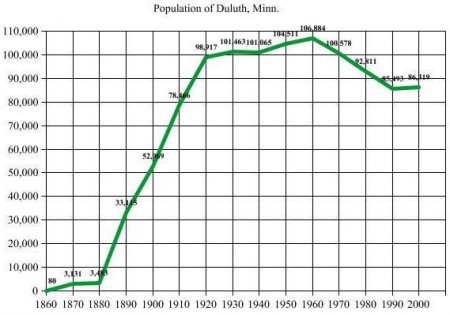Population of Duluth: 1860 to 2000
Update: A more recent version of this chart with 2010 and 2020 figures and additional notes is now available.
I can’t remember ever seeing a graph of Duluth’s population over time, so I made one. The results of the 2010 U.S. Census aren’t in yet, but the state demographer estimated a population of 85,220 in 2008, so perhaps a slight dip can be expected.
The topic for discussion: What is the ideal population for Duluth?
Before you answer, keep in mind that the number of households is continuing to increase. They used to cram a lot of people into houses back in the day, whereas now we prefer to spoil ourselves with space. In 1950 there were nearly three-and-a-half people per household. Now there’s just over two, on average. Which means the city is more crowded with houses in 2010 than it was when the population peaked in 1960.
Here’s the population numbers again, in case you can’t read them in the graph.
1860 – 80
1870 – 3,131
1880 – 3,483
1890 – 33,115
1900 – 52,969
1910 – 78,466
1920 – 98,917
1930 – 101,463
1940 – 101,065
1950 – 104,511
1960 – 106,884
1970 – 100,578
1980 – 92,811
1990 – 85,493
2000 – 86,319
Recommended Links:
Leave a Comment
Only registered members can post a comment , Login / Register Here















19 Comments
edgeways
about 15 years agotmart
about 15 years agomevdev
about 15 years agoRon
about 15 years agoTimK
about 15 years agobaci
about 15 years agochadp
about 15 years agoResol
about 15 years agoadam
about 15 years agoCodie
about 15 years agoWendy
about 15 years agoedgeways
about 15 years agoResol
about 15 years agoRich Pelto
about 14 years agoMegan
about 14 years agoPaul Lundgren
about 14 years agoPaul Lundgren
about 14 years agojohn hayward
about 14 years agoSteve E Knight
about 5 years ago